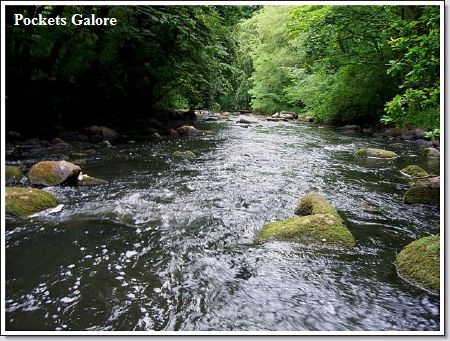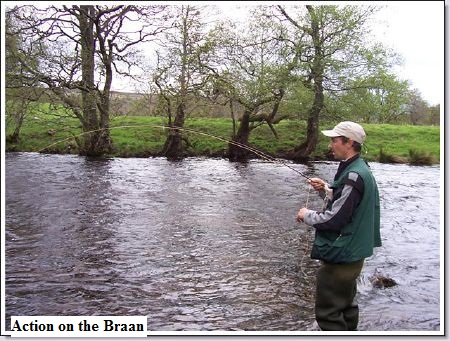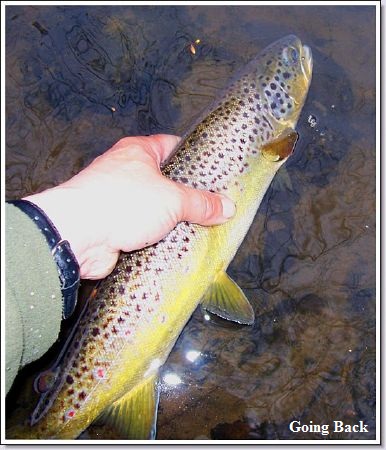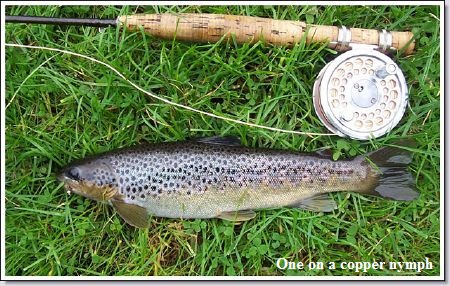Don't Go With The Flow
- Details
- Published on Wednesday, 28 February 2007 12:13
- Written by Colin Wilson
 Around five or six years ago, I paid a visit to my local trout stream. As nothing was rising, I put on my usual set-up, leaded harelug on the point and a spider pattern on the dropper. I was fishing my way downstream covering the water methodically with little success. Then I heard a fish rise behind me, just upstream. So I cast the same set-up
Around five or six years ago, I paid a visit to my local trout stream. As nothing was rising, I put on my usual set-up, leaded harelug on the point and a spider pattern on the dropper. I was fishing my way downstream covering the water methodically with little success. Then I heard a fish rise behind me, just upstream. So I cast the same set-up
in and around the area where the fish had last showed. I was rewarded with a take and a spirited brownie of around 10”came to hand. I’ve never looked back since - or should I say down?
 Scotland has an abundance of rain fed rivers and burns (mainly under fished), most of them fairly fast flowing and boulder strewn in nature, perfect water to fish an under-used method: the “the upstream nymph”. This is now my standard approach to a river. No specialist tackle is required for this sort of fishing. Leaders are simple, untapered and with one or maybe two droppers, whilst leader length is dictated by the size of the river. On a small overgrown burn I may go as short as a 6 foot leader with one dropper, and on decent sized rivers a 10 foot leader will usually suffice. I normally use breaking strains between 2-4lb. mono, depending on the clarity of the water, and don’t see the benefit from using more expensive fluorocarbons. Despite this being my set-up for nymph fishing, I always keep a dry fly stuck in the collar of my waistcoat ready to take out any actively rising fish.
Scotland has an abundance of rain fed rivers and burns (mainly under fished), most of them fairly fast flowing and boulder strewn in nature, perfect water to fish an under-used method: the “the upstream nymph”. This is now my standard approach to a river. No specialist tackle is required for this sort of fishing. Leaders are simple, untapered and with one or maybe two droppers, whilst leader length is dictated by the size of the river. On a small overgrown burn I may go as short as a 6 foot leader with one dropper, and on decent sized rivers a 10 foot leader will usually suffice. I normally use breaking strains between 2-4lb. mono, depending on the clarity of the water, and don’t see the benefit from using more expensive fluorocarbons. Despite this being my set-up for nymph fishing, I always keep a dry fly stuck in the collar of my waistcoat ready to take out any actively rising fish.
 Takes, whilst “upstream nymphing”, are registered by a stop or stab or unusual movement of the line. In pocket water they are often quite confident visual affairs which should be met with a lift of the rod to set the hook. Sometimes you may think the fly has hung up on a rock only to find a trout kicking at the end of the line. Having said that, ensure you have a plentiful supply of flies as some are destined to be lost on the bottom. If you do suspect that the fly is about to snag on a rock or any other debris, lift the rod - this will cause the nymph to rise towards the surface and often triggers a stubborn trout into taking. This is known as the induced take!
Takes, whilst “upstream nymphing”, are registered by a stop or stab or unusual movement of the line. In pocket water they are often quite confident visual affairs which should be met with a lift of the rod to set the hook. Sometimes you may think the fly has hung up on a rock only to find a trout kicking at the end of the line. Having said that, ensure you have a plentiful supply of flies as some are destined to be lost on the bottom. If you do suspect that the fly is about to snag on a rock or any other debris, lift the rod - this will cause the nymph to rise towards the surface and often triggers a stubborn trout into taking. This is known as the induced take!
At the start of the season fish are usually found in the slower parts of the river. Unfortunately I’ve found the upstream nymph method to be second best to the dry fly at this time of year. They tend to sink to the bottom and stay there. Current is the nymph angler’s best ally and once fish move into the streamier parts of the river the nymph comes in to its own. Heads of pools, riffles, seams and pocket water are where this technique is most at home.
From around the end of May, right the way to the end of the season, pockets and heads become the most productive water, especially where better fish are concerned. At first sight the rapids may look daunting, but a closer look will reveal small slower areas amongst the chaos. These are pockets and usually they contain at least one or two fish. Don’t get the idea that only small fish inhabit pockets, deep holes (honey pots) often occur amongst them and often they house a trout of up to a couple of pounds or more.
 For fishing pockets (I love fishing pockets, they are usually very under fished and productive) and heads a short line upstream and occasionally a “Czech nymph” (in the fastest water, for line control) technique can be employed. Fly patterns are simple: harelug, pheasant tail, copper nymph, prince nymph etc. will be sufficient; often utilizing a lighter spider pattern on the dropper. The most important factor being that there is enough ballast to get down to the fish's level as they may only be in the water for two or three seconds each cast.
For fishing pockets (I love fishing pockets, they are usually very under fished and productive) and heads a short line upstream and occasionally a “Czech nymph” (in the fastest water, for line control) technique can be employed. Fly patterns are simple: harelug, pheasant tail, copper nymph, prince nymph etc. will be sufficient; often utilizing a lighter spider pattern on the dropper. The most important factor being that there is enough ballast to get down to the fish's level as they may only be in the water for two or three seconds each cast.
In August, traditionally a difficult month for day-time fishing, pockets may be the only answer to saving the blank. Oxygen levels and flow levels have depleted in the pools and fish are forced to move to faster oxygen rich water. Fast shallow water is also the home of the majority of the rivers nymph population (stone clingers especially) hence kick samples are usually taken from areas with a good flow.
 This is a basic guide on how to present nymphs. You will notice that I have barely mentioned the art of fishing them downstream. This is because I don’t like or rate the method. Upstream and rolled nymph techniques, although not rocket science, are under used and very productive methods which I would urge fellow anglers to master. Though not the be all and end all, it does add another string to the river angler’s bow.
This is a basic guide on how to present nymphs. You will notice that I have barely mentioned the art of fishing them downstream. This is because I don’t like or rate the method. Upstream and rolled nymph techniques, although not rocket science, are under used and very productive methods which I would urge fellow anglers to master. Though not the be all and end all, it does add another string to the river angler’s bow.
Colin Wilson , originally from Angus, now lives and works as a gardener in Linlithgow with his son Jack and his forgiving and tolerating wife Sylvia. His fishing tastes have widened over the years participating in and enjoying both river and loch wild trouting, fly fishing for pike and occasionally dabbling in a bit of course fishing.

